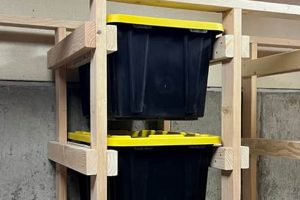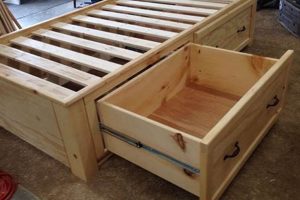Construction of a dedicated surface and organizational system for interlocking plastic bricks represents a popular home project. These projects typically involve modifying existing furniture or building new structures to provide both a play area and a method for containing and sorting the components. Variations can range from simple repurposed tables with added storage bins to elaborate custom-built units incorporating drawers, shelves, and integrated baseplates.
The appeal of creating such a setup lies in its potential to enhance the play experience while minimizing clutter. By providing a designated space, the project promotes focused engagement and reduces the likelihood of loose pieces scattered throughout the home. Historically, parents and educators have sought effective methods for managing building toys, leading to a proliferation of homemade and commercially available solutions designed to streamline both play and storage.
The following sections will delve into the various aspects of planning, designing, and executing these projects, covering considerations such as material selection, space optimization, and customization options. Furthermore, different approaches to construction and popular design ideas will be explored, providing readers with a foundation for embarking on their own building brick organization solution.
Construction and Organization Guidelines
The following guidelines provide practical advice for constructing and maintaining an effective building brick workstation. Attention to detail during the planning and execution phases will result in a more functional and durable setup.
Tip 1: Prioritize a Stable Base: A robust foundation is crucial. Ensure the table’s legs are securely attached and capable of supporting significant weight, accounting for both the bricks and the potential for children to lean on the structure.
Tip 2: Incorporate Baseplate Compatibility: Integrate official or compatible baseplates onto the tabletop. This creates a secure building surface and prevents models from easily sliding off.
Tip 3: Opt for Accessible Storage: Utilize clear storage containers or drawers that allow for easy identification of contents. Categorize bricks by color, type, or project to streamline the building process.
Tip 4: Consider Ergonomic Height: Adjust the table height to a comfortable level for the intended users. This minimizes strain during extended play sessions.
Tip 5: Maximize Vertical Space: Employ wall-mounted shelves or pegboards to expand storage capacity without increasing the table’s footprint. This is particularly beneficial in smaller spaces.
Tip 6: Implement a Sorting System: Establish a regular routine for sorting and organizing bricks. This prevents clutter and makes it easier to locate specific pieces when needed. A dedicated sorting tray with compartments can be a valuable tool.
Tip 7: Utilize Under-Table Storage: Install drawers or shelves beneath the table to maximize storage efficiency. These spaces can be used to store larger sets, instruction manuals, or completed models.
Adhering to these guidelines will result in a designated space that promotes creativity, minimizes clutter, and encourages a more organized approach to building brick activities. The principles of stability, accessibility, and efficient space utilization are paramount to creating a functional and enjoyable environment.
The subsequent section will discuss the long-term maintenance and adaptations that can further enhance the usability of the building brick workstation.
1. Surface Area
Surface area, in the context of a customized building brick setup, directly correlates to the scale and complexity of projects that can be undertaken. Adequate surface area enhances the building experience by providing sufficient space for construction, organization, and display.
- Project Scale
Larger surface areas accommodate larger, more intricate models. Complex architectural builds or sprawling landscapes require significant horizontal space for assembly and display. Conversely, limited surface area restricts the scope of potential projects, necessitating either smaller constructions or a piecemeal building approach.
- Organizational Efficiency
Adequate surface area facilitates the organization of bricks during the building process. A larger workspace allows builders to spread out components, categorize them by type or color, and readily access needed pieces. Inadequate surface area results in cluttered workspaces, hindering efficiency and potentially increasing the time required to complete a project.
- Collaborative Building
Sufficient surface area supports collaborative building activities. Multiple individuals can simultaneously work on a project, contributing to different sections or aspects of the model. Smaller surfaces limit participation, potentially leading to overcrowding and restricted movement, thereby diminishing the collaborative experience.
- Display and Presentation
Extended surfaces provide opportunities for displaying completed models or works in progress. Showcasing intricate details or overall scale becomes viable, enhancing the satisfaction derived from the building process. Constrained surfaces limit the potential for effective display, potentially requiring disassembly or off-site storage of finished creations.
The implications of surface area extend beyond mere dimensions, influencing the user’s capacity for project complexity, organizational efficiency, collaborative building, and model display. Therefore, careful consideration of surface area is crucial when designing a building brick workstation.
2. Storage Capacity
Storage capacity forms a critical element in the functionality of a customized building brick workstation. The ability to efficiently store and organize components directly impacts the building process and the overall user experience.
- Volume of Collection
The sheer volume of building bricks owned directly influences the required storage capacity. Larger collections necessitate more extensive storage solutions, potentially involving multiple drawers, bins, or shelves. Inadequate storage leads to disorganized collections, making it difficult to locate specific components and impeding the building process. For example, a collection consisting of thousands of bricks requires significantly more storage space than a smaller, curated selection.
- Categorization Needs
Effective categorization enhances the efficiency of building. Storage capacity must accommodate different sorting methodologies, such as organizing bricks by color, type, or project. Insufficient capacity limits the ability to effectively categorize components, resulting in time-consuming searches for specific pieces. A well-designed system might allocate separate containers for different sizes of plates, bricks, and specialty elements.
- Accessibility Requirements
Storage solutions should prioritize accessibility, allowing for the easy retrieval of components during building. High-capacity storage that is difficult to access diminishes its value. Drawers, bins, or shelves should be arranged to maximize visibility and reachability. A system with deep, opaque containers may hinder the building process compared to one with shallow, transparent bins.
- Future Expansion
Consideration should be given to future expansion of the building brick collection. The storage solution should be designed to accommodate potential increases in volume. Failure to plan for future expansion necessitates costly redesigns or the implementation of secondary storage solutions. A modular storage system allows for the incremental addition of containers or shelves as the collection grows.
These facets of storage capacity directly influence the usability and effectiveness of a customized building brick workstation. Efficiently managing and accessing components is paramount to fostering a positive and productive building environment. Neglecting storage capacity results in a cluttered and frustrating experience.
3. Accessibility
Accessibility, in the context of customized building brick workstations, refers to the ease with which a user can retrieve, manipulate, and utilize the building components and the workspace itself. This aspect directly influences the flow of the building process and the overall engagement with the activity. Poor accessibility can lead to frustration, decreased focus, and ultimately, a less enjoyable building experience. For instance, if bricks are stored in opaque, unlabeled containers stacked high on a shelf, accessing a specific piece becomes a cumbersome and time-consuming task. This impedes the creative process and diminishes the spontaneous nature of building.
The design of building brick storage solutions should prioritize unobstructed reach and clear visibility. Transparent containers or drawers facilitate quick identification of contents without requiring extensive searching. Similarly, arranging storage units within a comfortable reach range, minimizing the need to stretch or bend, enhances accessibility for users of all ages and physical abilities. Examples of effective design include shallow drawers divided into compartments for different brick types, labeled storage bins with easy-to-grip handles, and open shelving that displays the collection in an organized manner. Conversely, deep containers, cluttered surfaces, and poorly lit workspaces detract from accessibility and hinder the building process. Furthermore, the height of the building surface itself contributes to accessibility; a surface that is too low can cause back strain, while one that is too high can make it difficult to reach components.
In conclusion, accessibility is not merely a convenience but a fundamental component of an effective building brick environment. By focusing on clear visibility, convenient reach, and ergonomic design, these workspaces can foster creativity, promote organization, and enhance the building experience for users of all ages and abilities. Overlooking accessibility can transform a potentially enjoyable activity into a frustrating chore. Consequently, integrating accessible design principles is essential when crafting a customized building brick workstation.
4. Ergonomics
Ergonomics plays a pivotal role in the design and implementation of building brick workspaces. Prioritizing ergonomic principles mitigates physical strain, enhances comfort, and promotes prolonged engagement with the building activity. A properly designed workstation reduces the risk of musculoskeletal issues and contributes to a more enjoyable experience.
- Table Height and Posture
The height of the table surface directly impacts posture. A table that is too low forces the user to bend over, leading to back and neck strain. Conversely, a table that is too high requires the user to raise their shoulders, causing discomfort in the upper back and neck. The ideal table height allows the user to maintain a neutral spine and relaxed shoulders. Adjustable-height tables offer flexibility and accommodate users of varying statures. For children, ensuring the table height is appropriate to their current height is crucial, and the table may need adjustment as they grow.
- Reach and Accessibility of Storage
The placement and design of storage solutions must consider reach and accessibility. Storage containers should be located within easy reach, minimizing the need to stretch or bend. Overly deep containers can force users to strain their backs while retrieving items. Clear, labeled containers positioned at a comfortable height improve visibility and reduce the time spent searching for specific components. Storage solutions that require excessive reaching or bending contribute to fatigue and potential injury.
- Chair Selection and Support
The chair used in conjunction with the building brick workstation significantly impacts comfort and posture. A chair with adjustable height and lumbar support promotes proper spinal alignment and reduces back strain. The seat depth should allow for adequate thigh support without pressing against the back of the knees. For younger users, a stable chair with appropriate back support is essential. The chair should enable the user to maintain a comfortable and sustainable posture throughout extended building sessions.
- Lighting and Visual Comfort
Adequate lighting is essential for minimizing eye strain and promoting visual comfort. Insufficient lighting forces the user to squint, leading to headaches and fatigue. Task lighting, such as an adjustable lamp positioned directly over the work surface, provides focused illumination and reduces glare. The lighting should be bright enough to clearly see small components but not so intense as to cause discomfort. Natural light, when available, can also contribute to a more pleasant and ergonomic workspace.
By incorporating these ergonomic considerations into the design of a building brick workspace, users can minimize physical strain, enhance comfort, and promote a more enjoyable and productive building experience. The principles of proper posture, accessible storage, supportive seating, and adequate lighting are fundamental to creating an ergonomic environment that supports long-term engagement with building brick activities. Failure to address these factors can lead to discomfort, fatigue, and potential musculoskeletal issues.
5. Material Durability
Material durability directly affects the longevity and functionality of a customized building brick workstation. The choice of materials dictates the structure’s resistance to wear and tear, weight-bearing capacity, and susceptibility to damage from moisture or impact. Inadequate material selection results in premature failure, necessitating repairs or replacement, thereby diminishing the cost-effectiveness and practicality of the project. For example, using low-grade particleboard for the table surface may lead to sagging under the weight of bricks and accessories, rendering the surface unstable and compromising its intended purpose. Similarly, using thin, brittle plastic for storage bins can result in cracking and breakage, leading to spillage and disorganization.
The selection of durable materials provides a stable and reliable platform for building activities. Hardwoods like maple or oak offer superior strength and resistance to scratches and dents, ensuring the table surface remains functional and aesthetically pleasing over time. Heavy-duty plastic storage bins or drawers withstand repeated use and prevent breakage, maintaining organization and minimizing the risk of lost or damaged components. Laminate surfaces, while potentially less durable than solid wood, provide a cost-effective alternative with reasonable resistance to wear and moisture. Furthermore, the use of robust hardware, such as sturdy hinges and drawer slides, contributes to the overall durability of the structure, preventing premature failure of moving parts. Consideration of material durability extends to the finishes applied to the surface, with durable paints or varnishes protecting against spills and stains, thereby preserving the appearance and integrity of the workstation.
In summary, material durability constitutes a fundamental design consideration for building brick workstations. Selecting robust and resilient materials ensures the structure can withstand the demands of regular use, maintaining functionality, organization, and aesthetic appeal over time. Overlooking material durability leads to compromised performance, premature failure, and reduced value, underscoring the importance of informed material selection in these building projects. The long-term benefits of utilizing durable materials far outweigh the initial cost savings associated with inferior alternatives, contributing to a sustainable and enjoyable building brick environment.
Frequently Asked Questions
This section addresses common inquiries regarding the design, construction, and maintenance of customized building brick workstations. The aim is to provide clear, concise answers to assist individuals in creating effective and durable solutions.
Question 1: What is the optimal table height for a building brick workstation?
The optimal table height is determined by the user’s height and should allow for a neutral posture. Generally, the tabletop should be at a height where the user’s elbows are bent at a 90-degree angle when standing or sitting in a supportive chair.
Question 2: What are the key considerations when selecting storage containers?
Key considerations include transparency for easy identification of contents, durability to withstand repeated use, accessibility for effortless retrieval, and appropriate size to accommodate the quantity and type of bricks being stored.
Question 3: How can baseplates be effectively integrated into a table surface?
Baseplates can be affixed to the table surface using adhesive. Ensure the surface is clean and smooth before application. Alternatively, consider a recessed design where the baseplate sits flush with the table surface, offering a seamless and secure integration.
Question 4: What are the advantages of using a modular storage system?
A modular storage system offers flexibility and scalability. Components can be added or rearranged to accommodate changing storage needs, allowing for adaptation to a growing building brick collection or evolving organizational preferences.
Question 5: How can the workspace be optimized for collaborative building activities?
Optimizing for collaboration involves providing ample surface area to accommodate multiple builders, ensuring accessible storage for shared components, and arranging the workspace to facilitate communication and interaction.
Question 6: What measures can be taken to prolong the lifespan of a building brick workstation?
Regular cleaning, protection from moisture, avoidance of excessive weight, and periodic inspection and tightening of fasteners are all measures that can prolong the lifespan of the workstation. Selecting durable materials during construction is also critical.
In summary, careful consideration of ergonomic principles, storage solutions, and material selection is essential for creating a functional and durable building brick workstation. Regular maintenance ensures continued usability and longevity.
The following section will explore advanced design concepts and customization options for building brick workspaces.
DIY Lego Table and Storage
The preceding sections have detailed the multifaceted considerations involved in creating “diy lego table and storage” solutions. Surface area, storage capacity, accessibility, ergonomics, and material durability represent critical elements in maximizing the functionality and longevity of these customized spaces. Successfully integrating these factors results in a dedicated environment that promotes creativity, organization, and sustained engagement with building brick activities.
The implementation of well-considered “diy lego table and storage” designs transcends mere convenience; it establishes a framework for focused learning and imaginative exploration. Continued refinement and adaptation of these spaces, guided by user needs and evolving collections, will ensure their enduring value as platforms for both play and practical organization.







